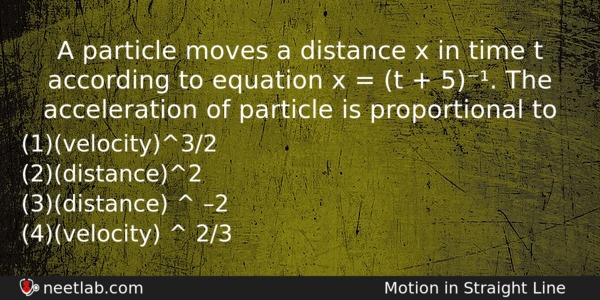| ⇦ | 
| ⇨ |
A particle moves a distance x in time t according to equation x = (t + 5)⁻¹. The acceleration of particle is proportional to
Options
(a) (velocity)^3/2
(b) (distance)^2
(c) (distance) ^ –2
(d) (velocity) ^ 2/3
Correct Answer:
(velocity)^3/2
Explanation:
x = 1 / t + 5
v = dx / dt = -1 / (t + 5)²
a = d²x / dt² = 2 / (t + 5)³ = 2x³
Now, 1 / (t + 5) ∞ v½
1 / (t + 5)³ ∞ v³/² ∞ a
Related Questions: - A cylindrical capacitors has charge Q and length L. If both the charge and length
- In which of the processes, does the internal energy of the system remain constant?
- Which of the following does not increase regularly?
- Carbon,silicon and germanium have four valence electrons each. At room temperature
- In the adiabatic compression, the decrease in volume associated with
Topics: Motion in Straight Line
(93)
Subject: Physics
(2479)
Important MCQs Based on Medical Entrance Examinations To Improve Your NEET Score
- A cylindrical capacitors has charge Q and length L. If both the charge and length
- In which of the processes, does the internal energy of the system remain constant?
- Which of the following does not increase regularly?
- Carbon,silicon and germanium have four valence electrons each. At room temperature
- In the adiabatic compression, the decrease in volume associated with
Topics: Motion in Straight Line (93)
Subject: Physics (2479)
Important MCQs Based on Medical Entrance Examinations To Improve Your NEET Score
18000+ students are using NEETLab to improve their score. What about you?
Solve Previous Year MCQs, Mock Tests, Topicwise Practice Tests, Identify Weak Topics, Formula Flash cards and much more is available in NEETLab Android App to improve your NEET score.
Share this page with your friends

Thankyou